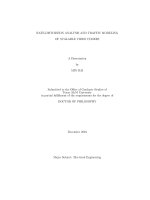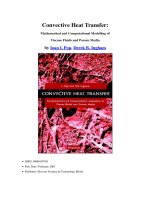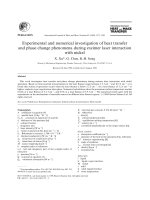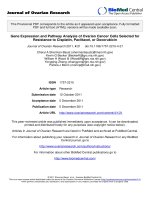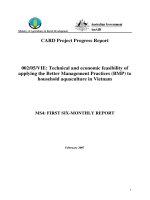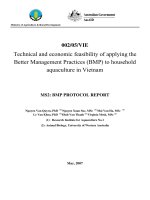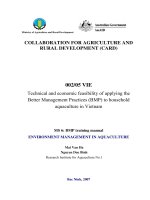CENTRIFUGE AND NUMERICAL MODELLING OF SOFT CLAY PILE RAFT FOUNDATIONS SUBJECTED TO SEISMIC SHAKING
Bạn đang xem bản rút gọn của tài liệu. Xem và tải ngay bản đầy đủ của tài liệu tại đây (5.08 MB, 349 trang )
CENTRIFUGE AND NUMERICAL MODELLING
OF SOFT CLAY-PILE-RAFT FOUNDATIONS
SUBJECTED TO SEISMIC SHAKING
SUBHADEEP BANERJEE
NATIONAL UNIVERSITY OF SINGAPORE
2009
ii
CENTRIFUGE AND NUMERICAL MODELLING
OF SOFT CLAY-PILE-RAFT FOUNDATIONS
SUBJECTED TO SEISMIC SHAKING
SUBHADEEP BANERJEE
(M.Tech., IIT Roorke)
A THESIS SUBMITTED
FOR THE DEGREE OF DOCTOR OF PHILOSOPHY
DEPARTMENT OF CIVIL ENGINEERING
NATIONAL UNIVERSITY OF SINGAPORE
2009
“If we knew what it was we were doing, it would not be called
research, would it?”
……. Albert Einstein
ii
ACKNOWLEDGEMENTS
This thesis represents the hard work of many individuals to whom I could
never express the extent of my gratitude. First and foremost, I express my sincere
and profound gratitude to my supervisors, Prof. Lee Fook Hou and Asst. Prof.
Goh Siang Huat for their erudite and invaluable guidance throughout the study.
Their gratitude, analytical and methodical way of working has inspired me and
under their guidance I have learned a lot. Whether the troubleshooting for the
centrifuge experiments or the debugging of the constitutive relationship, they have
always a number of solutions at their disposal. Prof. Lee and Dr. Goh’s assistances
during the preparation of this thesis are also appreciated.
I am extremely grateful to Dr. Zhao Pengjun for sparing his valuable time
to give me necessary training and suggestion on shaking table and centrifuge
operation before the test.
Grateful thanks are extended to the staff of the Geotechnical Centrifuge
Laboratory, National University of Singapore for their assistance rendered
throughout the study. Mr. L. H. Tan and Mr. C. Y. Wong had been extremely
helpful during the centrifuge tests. Madam Jamilah, Mr. H. A. Foo and Mr. L. H.
Loo provided all the necessary expertise and support during the advanced triaxial
and resonant column tests. Mr. Shaja Khan, Mrs. Leela and Miss Sandra
generously provided all the transducers and computer facilities.
I wish to thank all the final year students and the exchange students, of
which Ma Kang from China and Celine Barni from France need special mention,
for their constant help in those grueling days of experiments.
iii
The friendship and collaboration with a number of my fellow graduate
students has also been invaluable. Special thanks are given to Mr. Xiao Huawen,
Mr. Sanjay Kumar Bharati, Mr. Yi Jiangtao, Mr. Yeo Chong Hun, Mr. Zhao Ben,
Mr. Sindhu Tjahyono, Miss Gan Cheng Ti, Mr. Chen Jian, Mr. Karma, Mr.
Krishna Bahadur Chaudhary, Mr. Tan Czhia Yheaw, Dr. Ong Chee Wee, Dr. Xie
Yi, Dr. Teh Kar Lu, Dr. Cheng Yonggang, Dr. Ma Rui, Dr. Zhang Xiying, Dr.
Okky Ahmad Purwana and Dr. Gu Quian. Mate, if I miss your name, call me; I
will buy you lunch!
I would also like to acknowledge NUS for providing all necessary
financial and academic support without which my Ph.D. would have been a
distinct dream.
Words are not enough to thank my family for the support they have given
me during this long and often difficult journey. I can only grab this opportunity to
remember their endless support to my pursuit of higher education.
A final word for all of you, who have been asking for the last one year,
"When are you submitting ?" Well. Its my turn now!!
iv
TABLE OF CONTENTS
Acknowledgements ii
Table of Contents iv
Summary xi
List of Tables xiv
List of Figures xv
List of Symbols xxv
Chapter 1: Introduction 1
1.1 Introduction ……………………………………………………………….1
1.2 Performance of Pile Foundations in Soft Clay: Past Experience …………2
1.3 Current Approaches for Designing Pile Foundations in Against Earthquake
Loading ……………………………………………………………………4
1.3.1 Different Code provisions ……………………………………… 4
1.3.1.1 Uniform Building Code …………………………………… 4
1.3.1.2 Eurocode recommendations ……………………………… 5
1.3.1.3 Caltrans Bridge Design Specifications………………………6
1.3.1.4 Indian Seismic Code Recommendations ………………… 6
1.3.1.5 People’s Republic of China Aseismic
Building Design Code ……………………………………7
1.3.1.6 Japanese Seismic Design Specifications ………………… 7
v
1.3.2 Current State-of-Art Practice for Seismic
Soil-Pile-Interaction Design ……………………………………… 8
1.4 Overview of Soil-Pile Interaction ……………………………………… 11
1.5 Objectives ……………………………………………………………… 13
1.6 Organization of Thesis……………………………………………… 14
Chapter 2: Literature Review 19
2.1 Dynamic Soil-Pile Response ……………………………………………19
2.1.1 Empirical Charts and Design Procedures ………………………….19
2.1.2 Analytical Methods ……………………………………………… 20
2.1.2.1 Elastic Continuum Approaches ……………………………20
2.1.2.2 The Lumped Mass Model ………………………………….23
2.1.2.3 Finite Element Analysis ………………………………… 24
2.1.3 Field Pile Dynamic Tests ………………………………………….27
2.1.4 Small-Scale Model Tests ………………………………………… 30
2.1.4.1 1-G Shaking Table Tests …………………………………31
2.1.4.2 Centrifuge Model Tests ………………………………… 34
2.1.5 Field Monitoring: Measured Pile Response During Earthquakes….38
2.1.6 Criteria for the Evaluation of the Pile Response………………… 41
2.2 Behaviour of Soft Clay ………………………………………………… 44
2.2.1 Non-linear and Stiffness Degradation Behaviour …………………45
2.2.2 Damping ………………………………………………………… 46
2.2.3 Modeling Cyclic and Strain-Rate Dependent Behaviour
of soft soil ………………………………………………………….48
2.3 Concluding Remarks …………………………………………………….50
vi
Chapter 3: Dynamic Properties of Kaolin Clay 68
3.1 Introduction …………………………………………………………… 68
3.2 Cyclic triaxial tests ………………………………………………………69
3.2.1 Preparation of Test Specimens…………………………………… 69
3.2.2 GDS Advanced Triaxial Apparatus………………………………. .70
3.2.3 Ranges of Cyclic Triaxial Test Conditions ……………………… 71
3.2.4 Calculation of Shear Modulus and Damping ……………………. .71
3.2.5 Limitations …………………………………………………………72
3.3 Resonant Column Tests ………………………………………………….72
3.3.1 Drnevich Long-Tor Resonant Column Apparatus ………………. .72
3.3.2 Calculation for Small Strain Shear Modulus and Damping Ratio 73
3.4 Tests Results and Analysis ………………………………………………76
3.4.1 Shear Modulus …………………………………………………… 78
3.4.1.1 Calculation of G
max
……………………………………… 78
3.4.1.2 Effect of Shear Strain Amplitude ………………………….79
3.4.1.3 Effect of Frequency……………………………………… 81
3.4.1.4 Effect of Cycles…………………………………………….82
3.4.1.5 Shear Modulus and Change in Effective Stress……………84
3.4.2 Damping ratio …………………………………………………… 84
3.4.2.1 Effect of Shear Strain Amplitude ………………………….84
3.4.2.2 Effect of Frequency ……………………………………… 86
3.4.2.3 Effect of Cycles ……………………………………………87
3.4.2.4 Damping Ratio and Change in Effective Stress ………… 87
3.4.3 Summary of Tests Results …………………………………………88
3.5 A Strain Dependent Hyperbolic Hysteretic Soil Model …………………89
vii
3.5.1 Theoretical Formulation of the Proposed Model………………… 89
3.5.1.1 Hyperbolic Backbone Curve……………………………….90
3.5.1.2 Modeling the Hysteretic Behaviour of
Soils: Masing’s Rules …………………………………… 95
3.5.1.3 Damping Characteristics of the Proposed Model ………… 99
3.5.1.4 Correlation of Modulus Degradation and Damping Ratio with
Plasticity Index ……………………………… 100
3.5.1.5 Modeling of Stiffness Degradation of Backbone Curve
……………………………………………………………… … 104
3.5.2 Numerical Simulation of Triaxial Test ………………………… 107
3.5.2.1 3D Triaxial Modelling using ABAQUS ………………… 107
3.5.2.2 Model Performance for Test Series CT1 and CT2
………………………………………………………… ……… 107
3.5.2.3 Model Performance for Test Series TRS1, TRS 2 and TRS 3
…………………………………………………………………….108
3.5.2.4 The Modulus Reduction and Damping Characteristics
……………………………………………………………….……110
3.5.3 Concluding Remarks ……………………………………………111
Chapter 4: Centrifuge Model Test Set-Up and Calibration
Results 146
4.1 Introduction …………………………………………………………….146
4.2 Centrifuge Test Set-Up………………………………………………….146
4.2.1 Structure of Centrifuge ………………………………………… 146
4.2.2 Viscosity Scaling Issue ………………………………………… 147
viii
4.3 Shake Table …………………………………………………………….152
4.3.1 Laminar Box …………………………………………………… 152
4.3.2 Shaking Apparatus ……………………………………………….153
4.4 Transducers…………………………………………………………… 154
4.5 Preparation of Soft Clay Bed Model……………………………………155
4.5.1 Preparation of Clay Slurry ……………………………………… 155
4.5.2 Consolidation of Clay Slurry …………………………………….156
4.6 Input Ground Motions ………………………………………………….157
4.7 Results and Observations ………………………………………………158
4.7.1 Medium Earthquake (PGA=0.07g), 1
st
Cycle ……………………158
4.7.2 Large Earthquake (PGA = 0.1g), 1
st
Cycle ………………………159
4.7.3 Large Earthquake (PGA = 0.1g), 2
nd
Cycle ………………………159
4.7.4 Summary of the Test Data ……………………………………… 160
4.8 Numerical Analysis on Seismic Behaviour of Soft Clay ………………160
4.8.1 Model Description ……………………………………………… 161
4.8.2 Comparison of Centrifuge and FEM Results …………………….162
4.9 Concluding Remarks ………………………………………………… 163
Chapter 5: Centrifuge Modelling of Seismic Soil-Pile-Raft
Interaction and its Numerical Back Analyses
184
5.1 Introduction …………………………………………………………….184
5.2 Centrifuge Tests Results ………………………………………………. 187
5.2.1 Acceleration Response of Clay-Pile-Raft System ……………… 187
ix
5.2.2 Resonance Periods of Different Pile Systems and Super-structure
Masses
…………………………………………………………………….190
5.2.3 Amplification …………………………………………………… 191
5.2.4 Bending Moment Response of Pile ………………………………192
5.2.4.1 Effect of Different Earthquakes ………………………….194
5.2.4.2 Effect of Different Added Masses ……………………….195
5.2.4.3 Effect of Different Pile Material …………………………195
5.3 Numerical Analysis of Seismic Soil-Pile Interaction ………………… 196
5.3.1 Effect of Joint Flexibility ……………………………………… 198
5.3.2 Comparison of Centrifuge and FEM Results:
Acceleration Responses ………………………………………… 200
5.3.3 Comparison of Centrifuge and FEM Results:
Bending Moment …………………………………………………202
5.3.4 Pile Tip Fixity Issue …………………………………………… 203
5.4 Concluding Remarks ………………………………………………… 205
Chapter 6: Parametric Studies on Earthquake-Induced Bending
Moment on a Single Pile 251
6.1 Introduction …………………………………………………………….251
6.2 Previous Works ……………………………………………………… 252
6.3 Dimensionless Groups for the Maximum Pile Bending Moment …… 254
6.4 Parametric Studies …………………………………………………… 258
6.5 Formulation of the Dimensionless Bending Moment Relationship ……259
x
6.6 Influence of Friction Angle …………………………………………….262
6.7 Comparison of Fitted Equation with Computed results ……………… 263
6.7.1 Effect of Pile Length …………………………………………… 264
6.7.2 Effect of Flexural Rigidity ……………………………………….265
6.7.3 Effect of Soil Modulus ………………………………………… 265
6.7.4 Effect of Raft …………………………………………………… 266
6.7.5 Effect of Peak Ground Acceleration (PGA) …………………… 267
6.8 Comparison with Centrifuge Results ………………………………… 268
6.9 Comparison with Design Charts Provided by
Tabesh And Poulos (2007) …………………………………………… 268
6.10 Concluding Remarks ………………………………………………….270
Chapter 7: Conclusions 292
7.1 Introduction …………………………………………………………….292
7.2 Summary of Research Findings ……………………………………… 293
7.2.1 Dynamic Properties of Kaolin Clay …………………………… 293
7.2.2 Centrifuge Model Tests ………………………………………… 294
7.2.3 Parametric Studies ……………………………………………… 295
7.3 Recommendations for the Further Research ………………………… 297
References 299
Appendix A 319
xi
SUMMARY
The behavior of pile foundations under earthquake loading is an important
factor affecting the performance of structures. Observations from past earthquakes
have shown that piles in firm soils generally perform well, while those installed in
soft or liquefiable soils are more susceptible to problems arising from ground
amplification or excessive soil movements.
The current thesis presents the details and results of a study on the seismic
response of pile-raft systems in normally consolidated kaolin clay due to far-field
earthquake motions. The research comprises four major components: (1) element
testing using the cyclic triaxial and resonant column apparatus to characterize the
dynamic properties of kaolin clay, the results of which were subsequently
incorporated into a hyperbolic-hysteretic constitutive relationship; (2) dynamic
centrifuge tests on pure kaolin clay beds (without structure) followed by 3-D finite
element back-analyses; (3) dynamic centrifuge tests on clay-pile-raft systems and
the corresponding 3-D finite element back-analyses and (4) parametric studies
leading to the derivation of a semi-analytical closed-form solution for the
maximum bending moment in a pile under seismic excitation.
The element test results showed that strain-dependent modulus reduction
and cyclic stiffness degradation feature strongly in the dynamic behaviour of the
clay specimens. In the centrifuge tests involving uniform clay beds without piles,
the effects of modulus reduction and stiffness degradation were manifested as an
increase in the resonance periods of the clay layers with the level of shaking and
with successive earthquakes. For the pile systems tested, the effect of the
surrounding soft clay was primarily to impose an inertial loading onto the piles,
xii
thereby increasing the natural frequency of the pile over and above that of the pile
foundation alone. There was also some evidence that the relative motion between
piles and soil leads to aggravated softening of the soil around the pile, thereby
lengthening its resonance period further.
In terms of the bending moment response, the maximum bending moment
was recorded near the fixed head connection between the pile and the raft. The
bending moment was found to increase almost linearly with the scaled earthquake
ground motion. It was also observed that the bending moment increases with the
flexural rigidity of the pile material and with increasing added masses on the pile
raft.
The centrifuge model tests were back-analysed using the finite element
code ABAQUS. The analyses, which were carried out using a user-defined total-
stress hyperbolic-hysteretic constitutive relationship (HyperMas), gave reasonably
good agreement with the experimental observations. The ability of the numerical
model to reasonably replicate the centrifuge tests suggests that the former may be
used to analyze conditions not considered in the centrifuge experiments, as well as
to carry out sensitivity studies. To facilitate the parametric studies, the method of
non-dimensional analysis, using Buckingham-π’s theorem, was carried out to
derive the dimensionless terms associated with the maximum bending moment in
a seismically loaded pile. The resulting semi-analytical solution for the maximum
bending moment was calibrated through parametric studies involving the pile
length, moment inertia, pile and soil modulus, mass of the raft and peak ground
motion.
xiii
Key words: earthquake, pile, soft clay, stiffness degradation, strain
softening, resonance period, amplification, bending moment, dimensionless
groups
xiv
LIST OF TABLES
Table 2.1 List of 1-g shaking table tests on model piles
(Meymand, 1998) ……………………………………………………53
Table 2.2 Scaling factors used by Meymand (Meymand, 1998) ………………54
Table 3.1 Geotechnical properties of kaolin clay (Goh, 2003)…………… 112
Table 3.2 Details of cyclic triaxial tests……………………………………….113
Table 3.3 Details of resonant column tests ……………………………………114
Table 4.1 Centrifuge scaling relations (Leung et al., 1991) ……………… …165
Table 4.2 Geotechnical properties of the kaolin clay (Goh, 2003) ………… 166
Table 5.1 Different piles used for the study ………………………………… 207
Table 5.2 Mass of the added plates ………………………………………… 207
Table 5.3 Summary of test program for kaolin clay with pile-raft structure ….208
Table 6.1 The reference baseline parameters for the parametric study ……….271
Table 6.2 Calculation of critical length as recommended by Gazetas (1984)…272
Table 6.3 Critical length of the pile used in the current study calculated as per
Gazetas (1984) …………………………………………………… 272
Table 6.4 Comparison of centrifuge tests results with the predictions using the
fitted relationship (Eq. 6.11) ……………………………………… 273
xv
LIST OF FIGURES
Figure 1.1 Geological map of Singapore ………………………………………15
Figure 1.2 Plate tectonics of Indian ocean region …………………………… 15
Figure 1.3 Pile failures in 1906 San Francisco earthquake ……………………16
Figure 1.4 Failure of pile supported ten-storey building during
1985 Mexico earthquake ………………………………………… 16
Figure 1.5 Formation of gap during 1989 Loma Prieta earthquake……………17
Figure 1.6 Tilting of a tower block during 2001 Bhuj Earthquake…………… 17
Figure 1.7 Soil-pile interaction (Meymand, 1998) …………………………….18
Figure 2.1 Resonant frequency of vertical oscillation for a point-bearing pile
resting on a rigid stratum and carrying a static load W (after
Richart, 1962) …………………………………………………… 55
Figure 2.2 Nonlinear soil-springs (Wilson, 1998) …………………………… 55
Figure 2.3 Lumped mass model ……………………………………………….56
Figure 2.4 Load-deflection plot and equivalent p-y analysis of full-scale lateral
pile load test (Lam and Cheang, 1995) ………………………… 56
Figure 2.5 Shaking Table Model Pile Group Interaction Factor vs pile spacing
(Sreerama, 1993)………………………………………………… 57
Figure 2.6 (a) Small scale and (b) full scale shaking table
at UCB (Meymand, 1998) …………………………………………58
Figure 2.7 Similitude approach used by Meymand (Meymand, 1998) ……… 59
Figure 2.8 Large scale laminar box-shaking table
assembly at NIED, Japan (Kagawa et al, 2004) ………………… 60
Figure 2.9 Simplified centrifuge test set-up ………………………………… 60
Figure 2.10 Models used in U.C. Davis for dynamic tests
on clay (Christina et al., 1999) …………………………………….61
Figure 2.11 Calculated and recorded accelerations, peak bending moments and
displacements (Christina et al., 1999)…………………………… 62
xvi
Figure 2.12 Spherical Tank structure instrumentation plan and pile cap to free
field transfer function (Hamada and Ishida, 1980)………… …….63
Figure 2.13 LNG Storage tank pile bending and axial strain spectra at two
different liquid heights (Tsujino et al., 1987)………………………63
Figure 2.14 Hollywood Storage Building Parking Lot/ Basement transfer
function during the Whitter Narrows earthquake (Fenves and Serino,
1992)……………………………………………………………….64
Figure 2.15 (a) Nonlinear stress-strain relation of
San Francisco Bay Mud (Idriss et al., 1978) and
(b) Cyclic test result on soft clay by Puzrin et al. (1995)
……………………………………………………………….…… 65
Figure 2.16 Determination of damping ratio from hysteretic loops.
(Kim et. al. 1991) ……………………………………………… 65
Figure 2.17 Stiffness degradation as modeled by Idriss et al., 1978 ………. .…66
Figure 2.18 Stiffness degradation with cyclic loading in quasi-static
pile load test (Snyder, 2004) ………………………………………68
Figure 3.1 Strain range applicable for different test methods (Mair, 1993) 115
Figure 3.2 Preparation of kaolin clay specimens ………………………… 115
Figure 3.3 GDS advanced triaxial apparatus .……………………………… 116
Figure 3.4 Schematic diagram of the cyclic triaxial set-up …………………116
Figure 3.5 Sleeve Component used for cyclic triaxial tests ……………… 117
Figure 3.6 Coupling connection between top cap and loading ram ……… 117
Figure 3.7 Determination of G and D from hysteretic
loops. (Kim et al. 1991) ………………………………………… 118
Figure 3.8 Hardin- Drnevich resonant column apparatus ……………………118
Figure 3.9 Schematic diagram of the resonant column apparatus ………… 119
Figure 3.10 Comparison of soil and air damping ratio ……………………… 119
Figure 3.11 Typical (a) stress-strain loops and (b) stress-paths
from CT1-5 (cyclic strain = 0.789%, cell pressure = 200kPa and
frequency=1Hz) ………………………………………………….120
Figure 3.12 (a) Stress-strain loops and (b) stress-paths
xvii
from CT3-1 (Virgin sample, cyclic strain=0.789%, cell pressure =
200kPa and frequency = 1 Hz) ………………………………….121
Figure 3.13 (a) Stress-strain loops and (b) stress-paths
from CT3-2 (cyclic strain = 1.37%, cell pressure = 200kPa and
frequency = 1 Hz) ……………………………………………….122
Figure 3.14 Small strain shear modulus values from RC tests ……………… 123
Figure 3.15 Typical stress-strain loop as obtained
from CT1-5 (cyclic strain = 0.789%, cell pressure = 200kPa and
frequency = 1.0Hz, 1
st
cycle) ……………………………………123
Figure 3.16 Variation of G/G
max
with shear strain from cyclic triaxial tests and
resonance column tests (present study) and reported trends (from
published literature) ……………………………………………. 124
Figure 3.17 Variation of G/G
max
with frequency …………………………… 124
Figure 3.18 1
st
and 60
th
stress-strain loop as obtained
from CT1-5 (cyclic strain = 0.789%, cell pressure = 200 kPa and
frequency = 1.0Hz) ……………………………………………. 125
Figure 3.19 Variation of degradation index with shear strain during the loading
phase of 60
th
cycle …………………………………………… 125
Figure 3.20 For test CT1-6, 1
st
and 60
th
stress-strain loops for cyclic strain
amplitude of (a) 0.137% and (b) 0.254% ………………………126
Figure 3.21 Degradation index for Test CT1-1 (0.05Hz), CT1-3 (0.25Hz) and
CT1-5 (1Hz) ……………………………………………………127
Figure 3.22 Degradation of the shear modulus to change in effective stress 127
Figure 3.23 Variation of damping ratio with shear strain from cyclic triaxial
tests and resonance column tests (present study) and reported
trends (from published literature) ………………………………128
Figure 3.24 Increase in energy components with shear strain …………… 128
Figure 3.25 Variation of damping ratio with frequency, from cyclic triaxial tests
and resonance column tests …………………………………… 129
Figure 3.26 Energy dissipated in first loop for different frequencies ………129
Figure 3.27 Energy stored during loading phase for different frequencies …130
Figure 3.28 Variation of damping ratio with increasing number of load cycles
(Test CT1-6) ………………………………………………… 130
xviii
Figure 3.29 Energy dissipation with increasing number of load cycles …….131
Figure 3.30 Effect of change in effective stress on damping ratio………… 131
Figure 3.31 Comparison of G/G
max
computed from Eq. 3.33 with test data 132
Figure 3.32 G-p’ trend obtained from the proposed backbone
curve (Eq. 3.29) plotted with the cyclic triaxial test
results for virgin samples …………………………………… 132
Figure 3.33 Unloading-reloading relationship based on Masing’s rule …… 133
Figure 3.34 Pyke’s extension of original Masing’s rule (Pyke, 1979) ………133
Figure 3.35 Comparison of damping ratios computed from Eq. 3.43 with test
data …………………………………………………………… 134
Figure 3.36 Normalized modulus (R) vs. confining stress (p’) …………… 135
Figure 3.37 Damping ratio vs. shear strain for different confining stress and PI
………………… 135
Figure 3.38 Comparison of damping ratio computed for different PI with
published trends ……………………………………………… 136
Figure 3.39 Comparison of G/G
max
computed for different PIs
with published trends ………………………………………… 137
Figure 3.40 Comparison of G
sec
/G
max
for low-plasticity soil (PI=15%) at different
confining stresses with published trends………………………….138
Figure 3.41 Comparison of G/G
max
and damping ratio with Ishihara’s
relationship (Ishihara, 1996) …………… 139
Figure 3.42 Idriss’ (1980) hyperbolic fit between damage parameter (t)
and cyclic strain amplitude …………………………………… 140
Figure 3.43 Proposed relationship between damage parameter (t)
and cyclic strain amplitude …………………………………… 141
Figure 3.44 ABAQUS 3D quarter model for cyclic triaxial tests ………… 141
Figure 3.45 Comparison of measured and predicted stress-strain loops for three
different strains and three different frequencies ……………… 142
Figure 3.46 Comparison of proposed degradation relationship (Eq. 3.54) with
test series CT1-1, CT1-3 and CT1-5 ………………………… 143
xix
Figure 3.47 Comparison of computed and experimental degradation
index for test series TRS ……………………………………….144
Figure 3.48 Comparison of computed and experimental peak
deviator stress for test series TRS …………………………… 144
Figure 3.49 Measured and predicted G/G
max
values at different strains …….145
Figure 3.50 Measured and computed damping ratio values at
different strains …………………………………………………145
Figure 4.1 Schematic views of NUS Geotechnical Centrifuge …………….167
Figure 4.2 Sectional views of (a) Laminar box + shaking table assembly and
(b) Rectangular hollow ring …………………………………….168
Figure 4.3 Laminar box without soil ……………………………………… 169
Figure 4.4 Set-up of shaking table with test model on swing platform …… 170
Figure 4.5 Hydraulic power equipment and motion command amplifier … 170
Figure 4.6 PCB Piezotronics model 352C66 quartz piezoelectric
accelerometers ………………………………………………… 171
Figure 4.7 Saturation of pore pressure transducer (PPT) ……………………172
Figure 4.8 Instrumentation lay-out in the pure clay bed models
(longitudinal side view of laminar box) ………………………… 173
Figure 4.9 1-g consolidation of clay model under dead weights …………….173
Figure 4.10 Time histories of earthquake accelerations used in the centrifuge
tests ………………………………………………………………174
Figure 4.11 Time histories of prototype displacements for
use as centrifuge input motions ………………………………….174
Figure 4.12 Acceleration and displacement of the Great Sumatra-Andaman
(2004) Islands earthquake, recorded at the BTDF station.(Pan et al.
2007)…………………………………………………………… 175
Figure 4.13 Acceleration and displacement of the Great Nias-Simeulue (2005)
earthquake, recorded at the BTDF station. (Pan et al.
2007)………………………………………………………… ….175
Figure 4.14 Three cycles of nine earthquakes triggered in each
centrifuge test ……………………………………………………176
xx
Figure 4.15 Time histories, response spectra and amplification for medium
earthquake, first cycle ………………………………………… 177
Figure 4.16 Time Histories, response spectra and amplification for large
earthquake, first cycle ………………………………………… 178
Figure 4.17 Time Histories, response spectra and amplification for large
earthquake, second cycle ……………………………………….179
Figure 4.18 Resonance periods of the measured surface ground motions
associated with different input peak ground accelerations for the 9
Events over three earthquake cycles ……………………………180
Figure 4.19 ABAQUS half-model of the centrifuge clay-bed tests …………180
Figure 4.20 Modeling of laminar box motion in the ABAQUS finite element
analyses ………………………………………………………….181
Figure 4.21 Comparison of feedback from the actuator and base
acceleration …………………………………………………… 181
Figure 4.22 Comparison of typical ground response recorded in centrifuge tests
with the results from numerical simulations …………………….182
Figure 4.23 Comparison of measured and computed surface amplification
response …………………………………………………………183
Figure 4.24 Resonance period of the surface ground motion associated with
different peak ground acceleration applied at the base………… 183
Figure 5.1 Centrifuge model views and instrumentation lay-out for tests with
embedded pile-raft structure …………………………………… 209
Figure 5.2 Steel plates to simulate added masses ……………………………209
Figure 5.3 Strain gauge positions on the instrumented pile …………………210
Figure 5.4 Typical acceleration time histories measured in test with pile-raft
structure ………………………………………………………… 211
Figure 5.5 (a) Response spectra and (b) Amplification at clay surface (A3) and
at top of the raft (A4) …………………………………………… 212
Figure 5.6 Centrifuge test of pile-raft structure without soil ……………… 212
Figure 5.7 Resonance period of the pile raft (A4) associated with a) Small, b)
Medium and c) Large Earthquake ……………………………… 213
xxi
Figure 5.8 Resonance period of the clay surface (A3) associated with a) Small,
b) Medium and c) Large Earthquake …………………………… 214
Figure 5.9 Raft resonance periods derived from centrifuge tests for different
peak ground accelerations and different added masses ………… 215
Figure 5.10 Amplification at clay surface derived from centrifuge tests for
different peak ground accelerations of cycle 1 and different added
masses ……………………………………………………………216
Figure 5.11 Amplification at clay surface derived from centrifuge tests for
different peak ground accelerations of cycle 1 and 2 for different
added masses …………………………………………………… 217
Figure 5.12 Amplification at the raft top derived from centrifuge tests for
different peak ground accelerations of cycle 1 and different added
masses …………………………………………………………….218
Figure 5.13 Typical bending moment time histories measured in centrifuge test
with pile-raft structure (concrete in-filled pile) ………………… 219
Figure 5.14 Bending moment time histories at all five strain gauge levels, plotted
on the same axes(concrete in-filled pile) ……………………… 220
Figure 5.15 Maximum bending moment envelope for the
concrete-infilled pile …………………………………………… 220
Figure 5.16 Maximum bending moment envelopes for three scaled earthquakes
for the concrete-infilled pile …………………………………… 221
Figure 5.17 Variation of maximum bending moments with peak ground
acceleration at different strain gauge positions ………………… 221
Figure 5.18 Maximum bending moment envelopes during cycle 1 and 2 for three
scaled earthquakes ……………………………………………… 222
Figure 5.19 Maximum bending moment envelopes for three scaled earthquakes
at different added masses ……………………………………… 223
Figure 5.20 Normalised bending moment envelopes for three scaled earthquakes
at different added masses ……………………………………… 224
Figure 5.21 Bending moment at S1 vs. added masses for three scaled
earthquakes ……………………………………………………….225
Figure 5.22 Maximum bending moment envelopes for three scaled earthquakes
for three different pile types …………………………………… 226
xxii
Figure 5.23 Bending moment at S1 vs. EI of piles for three different earthquakes
and three different added masses …………………………………229
Figure 5.24 ABAQUS half-model for clay-pile-raft test …………………… 230
Figure 5.25 Flexible beam along the pile central axes to measure bending
moments ………………………………………………………….230
Figure 5.26 Calibration of pile-raft joint: (a) Measurement of pile deflection
and (b) Assumed cantilever mechanism ……………………… 231
Figure 5.27 Comparison of measured and theoretical pile tip deflection ……231
Figure 5.28 ABAQUS 3D model for pile-raft structure ………………………232
Figure 5.29 Comparison of the bending moment profiles with rigid joints and
joints with reduced stiffness …………………………………… 232
Figure 5.30 Comparison of typical acceleration response recorded in centrifuge
tests with numerical simulations (small earthquake) ………… 233
Figure 5.31 Comparison of measured and computed amplification (small
earthquake ……………………………………………………… 234
Figure 5.32 Computed resonance period of the pile raft (A4) associated with a)
Small, b) Medium and c) Large Earthquake …………………… 235
Figure 5.33 Computed resonance period at the clay surface (A3) associated with
a) Small, b) Medium and c) Large earthquake ………………… 236
Figure 5.34 Computed resonance period vs peak ground acceleration at clay
surface under different added masses …………………………….237
Figure 5.35 Computed Amplification vs peak ground acceleration at clay surface
for different piles under different added masses …………………238
Figure 5.36 Comparison of bending moment time histories measured in
centrifuge test with numerical simulation (small earthquake) … 239
Figure 5.37 Comparison of Maximum bending moment envelope measured in
centrifuge test with numerical simulation (small earthquake) … 240
Figure 5.38 Computed and measured maximum bending moment envelope for
three scaled earthquakes for concrete infill piles and added mass of
368 tonne …………………………………………………………241
Figure 5.39 Computed and measured maximum bending moment envelope for
three different scaled earthquakes and different added mass (concrete
in-fill pile) ……………………………………………………… 242
xxiii
Figure 5.40 Computed and measured maximum bending moment envelopes for
three scaled earthquakes and different added masses for three pile
types ………………………………………………………………243
Figure 5.41 Response spectra of the computed bending moment history …….246
Figure 5.42 Computed and measured acceleration time histories of the raft for
different assumed pile tip condition in the ABAQUS analysis … 246
Figure 5.43 Computed and measured response spectra of the raft for different
assumed material types supporting the pile types ……………… 247
Figure 5.44 Effect of different material types supported the pile on the solid piles
subjected to small earthquake …………………………………….247
Figure 5.45 Computed and measured maximum bending moment envelopes in
the solid piles for different added masses and different scaled
earthquakes with base sand layer modeled as a Mohr-Coulomb
material ………………………………………………………… 248
Figure 5.46 Computed and measured maximum bending moment envelopes in
the solid piles for different added masses and different scaled
earthquakes with base sand layer modeled as an elastic material
249
Figure 6.1 Numerical model used by Nikolau et al. (2001) …………………274
Figure 6.2 Idealized single pile-raft model used for dimensional analysis ….274
Figure 6.3 Comparison of maximum bending moment envelopes of different
diameter (0.5 m and 1.5 m), but with the same flexural rigidity….275
Figure 6.4a Dimensionless moment M
*
vs Slenderness Ratio (
e
p
d
l
) for different
combinations of pile types, added masses and scaled earthquakes.276
Figure 6.4b Dimensionless moment M
*
vs Frequency Ratio (a
0
) for different
combinations of pile types, pile lengths and scaled earthquakes…277
Figure 6.4c Dimensionless moment M
*
vs Mass Ratio (β) for different
combination of pile types, pile lengths and scaled earthquakes ….278
Figure 6.4d Dimensionless moment M
*
vs Dimensionless Acceleration (α) for
different combinations of pile types, pile lengths and added masses
……………… 279
Figure 6.5 Condensation of dimensionless moment and dimensionless
acceleration ……………………………………………………….280
